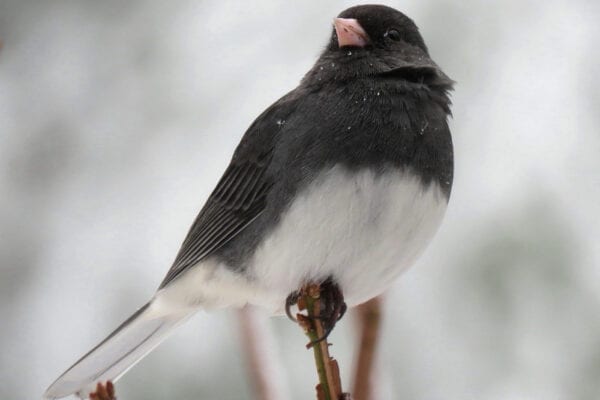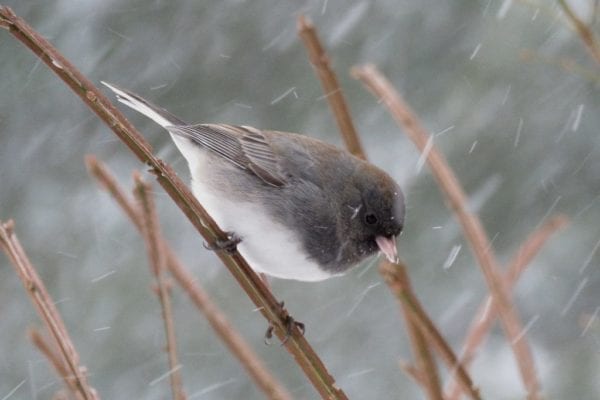
A Dark-eyed Junco looking very regal in the snow. Photo by Jayne Winters
Dark-eyed Junco
Junco hyemalis
Cool facts: The oldest recorded Dark-eyed Junco? At least 11 years, 4 months old when it was recaptured and rereleased during banding operations in West Virginia in 2001. It had originally been banded in 1991, also in West Virginia.
Interestingly, a flock of juncos is often referred to as a “blizzard.” That’s another good reason to call them “snowbirds”!
Two hundred years ago, John James Audubon wrote about the Dark-eyed Junco, calling it the “little Snow-bird.” Many of us still think of it as a “snowbird,” since it seems we start to notice them more as winter arrives. Maybe it’s because their slate gray color is such an obvious contrast to the white snow? Although they breed throughout Maine, the largest portion of their population nests in the Boreal forests of Canada. Beginning in late-fall, larger numbers begin arriving from Canada, and we’re more likely to start seeing them foraging in small flocks under our feeders and among leaf litter. They’re often seen feeding with other sparrows, finches, Mourning Doves, and cardinals.
The Dark-eyed Junco is one of the most common birds in North America and is found all across the continent, from Mexico to the Arctic and New England to California. Until the 1970s, it was classified as five separate species. At that time, the American Ornithologists’ Union (AOU) combined and subdivided the groups again.

Dark-eyed Junco weathering a snowstorm in South China, Maine. Photo by Jayne Winters
Dark-eyed Juncos, like others in the sparrow family, are primarily seed and berry eaters, but add insects to their diet for protein during breeding season. In fact, close to half of the adults’ summer diet is comprised of a wide variety of insects. Juncos in the western U.S. come in various color patterns, often reddish-brown or gray hooded. In the East, they are gray and white, with white outer tail feathers that are very noticeable during flight. Females and immature juncos are sometimes reddish-brown on their back and sides, but still have a lighter belly. They all have a pink bill and pink legs; their “song” is a high-pitched trill, which sounds similar to that of the Pine Warbler and Chipping Sparrow.
In courtship, both members of a pair may hop around on the ground with their wings drooped and the tail fanned out to display the white outer tail feathers. The cup-shaped nest is typically on the ground, hidden under tall grass, exposed roots, logs, rocks, or in shallow holes; occasionally, nests are found in shrubs, small trees, or even on building ledges—rarely more than 10 feet above ground. The female does most of the nest-building; she uses grass, weeds, and leaves, and sometimes lines it with feathers or hair.
The female junco lays three to five slightly glossy eggs, whitish to bluish white or pale gray, with brown and gray splotches usually at the larger end. Incubation is 11-13 days, solely by the female, but both parents feed the nestlings of a mostly insect diet. The youngsters leave the nest 9-14 days after hatching. Juncos will have one or two broods or “clutches” per year, sometimes three, before heading south for the winter.
Sadly, Dark-eyed Junco populations have declined by more than 40% in the last several decades. Like many other birds, they are vulnerable to climate change/habitat loss, predation, and window collisions. Although their numbers are decreasing, the Cornell Lab of Ornithology notes Dark-eyed Juncos are one of the most common species reported in its annual Project FeederWatch. Audubon scientists have used sophisticated climate models and more than 140 million bird observations to project how climate change will likely impact the junco’s range in the future. In Maine, climate modeling indicates the Dark-eyed Junco population will be “stable” in winter, but is at “high vulnerability” in the summer. Population estimates vary greatly, but are estimated to be in the hundreds of millions.
Written by Jayne Winters, January 25, 2023










